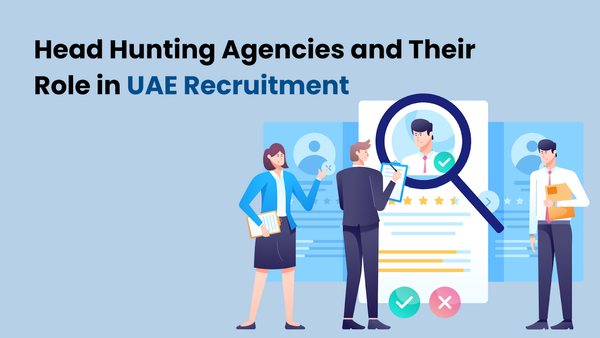Struggling to fill senior roles despite countless job ads and internal referrals? The right talent isn’t always actively looking; they need to be found. So how do you reach them?
That’s precisely what headhunting is designed to do. It’s a proactive approach to recruitment that targets passive talent- professionals who aren’t looking but may be open to the right opportunity. Instead of waiting for applications, headhunters go directly to the source.
Whether you’re hiring for a leadership role, niche skill, or business-critical position, head hunting can make all the difference.
In this guide, you'll find practical insights, proven strategies, and recruiter-first advice to help you navigate headhunting more confidently.
TL;DR
- Headhunting targets leadership and niche roles through direct, proactive recruitment.
- Employers can connect with high-calibre candidates not active on job boards.
- The head hunting process includes research, outreach, screening, and negotiation.
- Choose an agency based on industry knowledge, strong networks, and local insight.
What Should You Know About Headhunting?
Headhunting, or executive search, is a targeted recruitment approach for filling senior or specialised roles. When these roles open up, general job listings often won’t bring the right candidates to your door.
Head hunting offers a direct, highly targeted recruitment approach. Unlike standard recruitment, it doesn’t wait for candidates to apply. Instead, professional headhunters proactively identify and approach the most qualified individuals, often those who are not actively looking for a job.
Rather than “close matches,” headhunters focus on finding “exact matches” who bring the right experience, leadership qualities, and culture fit. This makes it an effective strategy for companies hiring for executive, technical, or niche roles where the stakes are high.
How It Differs from Traditional Hiring:
- Direct outreach: Reaches passive candidates through networks, research, and referrals.
- Discreet execution: Maintains confidentiality for sensitive or high-level roles.
- Tailored profiles: Prioritises long-term fit over fast volume hiring.
- Consultative role: Guides employers on positioning, salaries, and candidate engagement.
So, are they worth the investment? The real value of headhunters lies in what they bring to the table.
Why Use Headhunters?
If you're hiring for leadership, niche, or business-critical roles, standard job boards won’t deliver the right talent. Headhunters bring the expertise, reach, and insight needed to find the right candidates, beyond just a good-looking CV. Here's why headhunting can be a game-changer for your recruitment strategy.
- Access to Passive Talent: Headhunters tap into a hidden pool of candidates who are not actively job hunting but are open to new opportunities. This allows you to find top talent that traditional job postings might miss.
- Time and Cost Efficiency: Headhunting significantly reduces the time-to-hire, helping you fill critical roles quickly. Headhunters manage the entire process, from screening to final negotiations, saving your internal HR team valuable time.
- Expertise in Candidate Evaluation: Headhunters are skilled in evaluating candidates’ qualifications, assessing their skills, and ensuring cultural fit. This thorough vetting process leads to higher-quality hires who stay longer in the role.
- Confidentiality: For high-level positions, discretion is often necessary. Headhunters ensure confidentiality for both the company and the candidate, preserving privacy and minimising potential disruption to ongoing operations.
- Local Cultural Fit: In markets like the UAE, understanding local business culture and compliance is critical. Headhunters provide valuable insight into Emirati corporate norms and help source candidates that align with those expectations.
From stronger candidates to shorter timelines, the advantages are clear. And, if you’re considering this route, there’s a clear process behind how headhunters work that you should be aware of.
What Is The Process for Headhunting?
The head hunting process is built for precision. It’s not about attracting the most applicants, but about finding the right one. Unlike traditional recruitment, head hunting is thorough, proactive, and tailored to your organisation’s unique needs. Let’s break down how it works:
1. Understanding the Role and Company
Every search starts with clarity. Headhunters take time to understand your company’s culture, goals, and challenges. This step helps define the scope of the role beyond what’s listed in a job description.
They’ll also speak with hiring managers or leadership teams to map out the qualities, soft skills, and experience needed. This sets the foundation for targeting candidates who are not just qualified but strategically aligned.
2. Researching the Market
The next step is focused research. Headhunters explore industry movements, talent gaps, and competitor benchmarks to understand where the right candidates might be found.
This phase includes identifying relevant companies, roles, and sectors where potential candidates are likely to work. It helps sharpen the search and guides sourcing efforts effectively.
3. Sourcing Passive Candidates
The next step is sourcing candidates, which involves tapping into both active and passive talent pools. The goal is to find and approach passive candidates, those not actively looking, but open to compelling roles.
Headhunters tap into niche networks, industry databases, and direct outreach. This proactive method uncovers professionals who may not be visible on public platforms.
4. Screening and Engagement
Once identified, candidates are approached confidentially. The focus is on understanding their motivation, values, and current work context, not just ticking boxes on a CV.
Initial conversations help assess whether a candidate matches the role’s expectations. If aligned, deeper evaluation begins around skill sets, experience, and cultural fit.
5. Presenting a Shortlist
Only the most suitable candidates are shortlisted and shared with you. These profiles are often detailed, offering insights into the candidate’s strengths, potential impact, and career goals.
This means you spend less time on interviews and more time making the right decisions. The shortlist is tailored, curated, and based on strategy, not volume.
6. Interview Coordination
Your headhunter handles all interview logistics, including candidate prep, expectations, and feedback loops. This keeps the process seamless for both you and the candidate.
They also brief you on candidate motivations, preferred outcomes, and any red flags to watch for. It’s not just about scheduling; it’s about helping you run sharper interviews.
7. Offer Negotiation and Onboarding Support
Once you've selected a candidate, your headhunter supports negotiations. They help align expectations around salary, benefits, and joining timelines.
They also assist during onboarding, ensuring a smooth transition. This step protects your investment and reduces the risk of drop-offs before joining.
Also Read: Top Candidate Sourcing Tools for Recruiters in 2024
Tips for Successful Headhunting
Finding the right candidate takes more than just a list of names. Effective headhunting requires strategy, patience, and genuine connection. These practical tips help refine your approach and increase your success rate.
- Research thoroughlyDon’t just skim profiles. Use your network, social media, and public records to understand each candidate’s achievements, career trajectory, and fit for the role.
- Make your company visibleCandidates are more receptive if they already know your brand. Share insights, updates, and achievements consistently through your company’s website and social channels.
- Approach candidates tactfullyCold pitches feel transactional. Introduce yourself clearly, explain why you're reaching out, and highlight what makes the opportunity stand out.
- Build rapport If a candidate isn't interested now, nurture the relationship. You never know when their priorities will shift. Keep the conversation open and respectful.
- Don’t hesitate to cold-callWhile digital messages are common, a call can add a human touch. Just ensure you’re prepared and considerate of the candidate’s time.
Successful headhunting requires the right expertise. Choosing the right agency ensures you tap into the best talent, fast.
Challenges in Headhunting
Even with experience and strategy, headhunting comes with its share of hurdles. However, with the right tools, these challenges can be addressed head-on.
High Competition
Top-tier professionals are often approached by multiple firms, making them harder to attract. They rarely advertise their availability, leaving headhunters to compete for talent with other agencies or companies.
Solution: With access to over 700 million profiles, Tidyhire helps uncover passive candidates that competitors often miss.
Ensuring Cultural And Team Fit
While candidates may possess the right skills, their cultural fit with the company is essential. Without alignment, even the most qualified candidates can face difficulties adapting, causing turnover.
Solution: Tidyhire’s assessment tools examine both skill sets and cultural alignment, helping you shortlist candidates who resonate with your organisation’s ethos.
Communication Bottlenecks And Drop-Offs
Engaging passive talent requires timely follow-ups across various channels. Missed messages, long response times, and inconsistent outreach can cause candidates to lose interest and disengage with the opportunity.
Solution: Centralised outreach tools, such as those offered by Tidyhire, ensure consistent follow-ups that boost candidate engagement and response rates.
Compliance And Documentation
Managing visa regulations, work permits, and various labour laws can be challenging. Delays in handling compliance documentation can cause hiring to take longer, affecting the overall recruitment timeline.
Solution: Tidyhire offers structured workflows for tracking documentation and compliance steps, so hiring teams stay aligned with regional regulations effortlessly.
Market Fluctuations
Changes in industry demand, market conditions, or economic shifts can quickly alter hiring priorities. This can result in wasted efforts as recruitment strategies become outdated and no longer align with current needs.
Solution: Tools like Tidyhire offer real-time analytics to reveal sourcing success and market trends, allowing you to pivot strategies quickly.
Also Read: Head Hunting Agencies and Their Role in UAE Recruitment
How to Choose the Right Headhunting Agency?
Not all agencies are created equal, and finding one that aligns with your company’s needs can make all the difference.
When selecting a headhunting agency, focus on their industry expertise. Agencies familiar with your sector will better understand your hiring needs and have access to relevant talent. Check the agency's track record. Look at their history with specialised positions and get insights into their success rate through reviews and client testimonials.
Also, consider how well they understand cultural fit. In the UAE, alignment with workplace culture often matters more than technical skills. Market knowledge is equally important. Agencies familiar with the local job scene can guide you on salary trends and competition.
Lastly, pay attention to communication and credibility. A reliable agency keeps you updated, handles compliance confidently, and has a proven track record of placing candidates in similar roles.
Conclusion
Head hunting remains one of the most effective strategies for sourcing top-tier leadership and niche talent. With a clear process, the right agency, and a focus on long-term fit, businesses can overcome the usual challenges and build stronger teams. In competitive markets like the UAE, where cultural alignment and speed are critical, a smart headhunting approach offers a strategic edge.TidyHire helps modern recruiters simplify every stage of the head hunting process, from sourcing passive talent to improving candidate evaluation. With built-in outreach, screening, and analytics tools, it gives hiring teams the structure and flexibility they need to make informed decisions faster.
Start building a faster, smarter headhunting strategy. Book a quick demo with Tidyhire and see it in action.
FAQ’s
1. What is a headhunter in HR?
A headhunter is a recruitment specialist who proactively seeks qualified candidates for senior or niche roles, often not advertised publicly. They typically approach passive candidates who aren’t actively looking but may be open to relevant opportunities.
2. What is the difference between headhunting and staffing
Headhunting is targeted, often confidential, and focused on high-level or hard-to-fill roles. Staffing usually involves bulk hiring for temporary or entry-level positions, often through job postings and applicant screening.
3. What is an example of headhunting?
A headhunter may directly approach a CFO working at a competitor to offer a leadership role elsewhere. This method is common for executive hiring, where qualified candidates are few and highly sought after.
4. How to approach a headhunter?
Headhunting usually starts with research into a candidate’s background, achievements, and current role. Once all that is aligned, you can reach out with a tailored message explaining why the role is a great fit.
5. Which is better, a headhunter or a recruiter?
Both serve different needs: headhunters focus on critical roles, while recruiters support wider hiring goals. With technology advancements, platforms like Tidyhire can support both, making your hiring process faster and more strategic.


